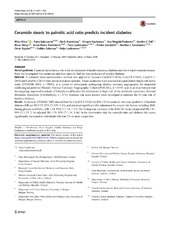| dc.contributor.author | Hilvo, Mika | en_US |
| dc.contributor.author | Salonurmi, Tuire | en_US |
| dc.contributor.author | Havulinna, Aki S. | en_US |
| dc.contributor.author | Kauhanen, Dimple | en_US |
| dc.contributor.author | Pedersen, Eva Ringdal | en_US |
| dc.contributor.author | Tell, Grethe S. | en_US |
| dc.contributor.author | Meyer, Klaus | en_US |
| dc.contributor.author | Teeriniemi, Anna-Maria | en_US |
| dc.contributor.author | Laatikainen, Tiina | en_US |
| dc.contributor.author | Jousilahti, Pekka | en_US |
| dc.contributor.author | Savolainen, Markku J. | en_US |
| dc.contributor.author | Nygård, Ottar | en_US |
| dc.contributor.author | Salomaa, Veikko | en_US |
| dc.contributor.author | Laaksonen, Reijo | en_US |
| dc.date.accessioned | 2020-06-03T13:37:45Z | |
| dc.date.available | 2020-06-03T13:37:45Z | |
| dc.date.issued | 2018-03-15 | |
| dc.Published | Hilvo M, Salonurmi, Havulinna AS, Kauhanen D, Pedersen ER, Tell GST, Meyer K, Teeriniemi, Laatikainen T, Jousilahti P, Savolainen MJ, Nygård O, Salomaa V, Laaksonen R. Ceramide stearic to palmitic acid ratio predicts incident diabetes. Diabetologia. 2018;61(6):1424-1434 | eng |
| dc.identifier.issn | 1432-0428 | |
| dc.identifier.issn | 0012-186X | |
| dc.identifier.uri | https://hdl.handle.net/1956/22448 | |
| dc.description.abstract | Aims/hypothesis Ceramide lipids have a role in the development of insulin resistance, diabetes and risk of cardiovascular disease. Here we investigated four ceramides and their ratios to find the best predictors of incident diabetes. Methods A validated mass-spectrometric method was applied to measure Cer(d18:1/16:0), Cer(d18:1/18:0), Cer(d18:1/24:0) and Cer(d18:1/24:1) from serum or plasma samples. These ceramides were analysed in a population-based risk factor study (FINRISK 2002, n = 8045), in a cohort of participants undergoing elective coronary angiography for suspected stable angina pectoris (Western Norway Coronary Angiography Cohort [WECAC], n = 3344) and in an intervention trial investigating improved methods of lifestyle modification for individuals at high risk of the metabolic syndrome (Prevent Metabolic Syndrome [PrevMetSyn], n = 371). Diabetes risk score models were developed to estimate the 10 year risk of incident diabetes. Results Analysis in FINRISK 2002 showed that the Cer(d18:1/18:0)/Cer(d18:1/16:0) ceramide ratio was predictive of incident diabetes (HR per SD 2.23, 95% CI 2.05, 2.42), and remained significant after adjustment for several risk factors, including BMI, fasting glucose and HbA1c (HR 1.34, 95% CI 1.14, 1.57). The finding was validated in the WECAC study (unadjusted HR 1.81, 95% CI 1.53, 2.14; adjusted HR 1.39, 95% CI 1.16, 1.66). In the intervention trial, the ceramide ratio and diabetes risk scores significantly decreased in individuals who had 5% or more weight loss. Conclusions/interpretation The Cer(d18:1/18:0)/Cer(d18:1/16:0) ratio is an independent predictive biomarker for incident diabetes, and may be modulated by lifestyle intervention. | en_US |
| dc.language.iso | eng | eng |
| dc.publisher | Springer | eng |
| dc.rights | Attribution CC BY | eng |
| dc.rights.uri | http://creativecommons.org/licenses/by/4.0/ | eng |
| dc.subject | Ceramide | eng |
| dc.subject | Diabetes | eng |
| dc.subject | Palmitic acid | eng |
| dc.subject | Prediction | eng |
| dc.subject | Prevention | eng |
| dc.subject | Risk | eng |
| dc.subject | Stearic acid | eng |
| dc.title | Ceramide stearic to palmitic acid ratio predicts incident diabetes | en_US |
| dc.type | Peer reviewed | |
| dc.type | Journal article | |
| dc.date.updated | 2020-01-28T09:32:41Z | |
| dc.description.version | publishedVersion | en_US |
| dc.rights.holder | Copyright 2018 The Author(s) | |
| dc.identifier.doi | https://doi.org/10.1007/s00125-018-4590-6 | |
| dc.identifier.cristin | 1590904 | |
| dc.source.journal | Diabetologia | |

